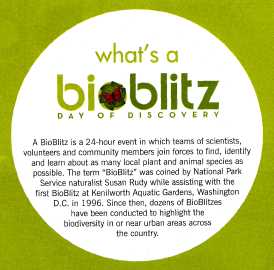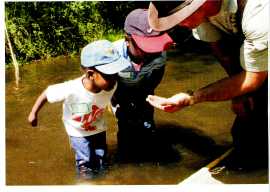 |
Home | Search | Browse | About IPO | Staff | Links |
 |
Home | Search | Browse | About IPO | Staff | Links |
26 I l l i n o i s P a r k s & R e c r e a t i o n www.ILipra.org 
discovering biodiversity in a local park Kids and adults waded in streams, netted butterflies and peered through binoculars and microscopes to discover an array of critters that make their home in a public park. Anna Page Park in Rockford was the site of northwestern Illinois' first-ever BioBlitz on May 19, 2007 and, as of this writing, organizers were putting the finishing touches on a second area BioBlitz for May 17, 2008 at the Byron Forest Preserve. BioBlitzing to Find the Wildlife that Lives Right Outside the Door "Short-term field collections of plants and animals called 'bioblitzes' are occurring throughout the United States to call attention to the rich biotic diversity of our local habitats," explained BioBlitz Coordinator Don Miller. "Too often we think that 'nature' is limited to what happens in the national parks, in the tropics or on the Discovery channel. Meanwhile the parks and wild places in our own neighborhoods are teeming with life." Last Spring in Rockford, Scientists from U.S. Fish & Wildlife Service, Illinois Natural History Survey, Natural Land Institute, North Central Illinois Ornithological Society, Sinnissippi Audubon, Byron Forest Preserve, Winnebago County Soil & Water Conservation District and the Illinois Mycological Society joined other professional biologists from across the stale to lead science teams in their areas of specialty. Jessi DeMartini and John Oldenburg from the Forest Preserve District of DuPage County led the insects and mussels portion of the aquatics research. Other highly qualified and experienced biologists ted teams of individuals on surveys of plants, trees and shrubs, insects, birds and fungi. www.ILparks.org M a y / J u n e 2008 27
An Intense, Hands-on, Real-world Environmental Education Event 
The day-long event was sponsored by the Four Rivers Environmental Coalition and was offered to the public free of charge, thanks to grants from the Community Foundation of Northern Illinois and the Environmental Education Association of Illinois. Other major sponsors were the Rockford Park District and the Winnebago County Forest Preserve District. About 100 local people teamed up with professional biologists to search for and identify a variety of plants and animals in the park. Nearly fifty more dropped in to observe the science teams at work, view natural science exhibits and partake in family nature activities. Perfect weather and a festive atmosphere at BioBlitz Central, including refreshments and prizes, enticed disc golfers and picnicking families to join in the BioBlitz activities. The inaugural project was sort of a mini-bioblitz. Site Planning Coordinator Kim Woodin explained, "We didn't want to get overly ambitious our first year. It was a lot to put together and promote, but with the support of all the cooperating agencies, it came off really well." Using Information Gathered in the BioBlitz One of the purposes of Bioblitz is to gather data that can be used to assess and monitor ecological conditions. DeMartini offered this commentary on Kent Creek, where the aquatics teams surveyed: "This creek is in fair condition. There are several taxa of water-quality-sensitive caddis flies, mayflies and craneflies here. I didn't see a lot of species that are highly tolerant to pollution, which means the water is decent quality for a stream in a developed area." Oldenburg explained that knowledge of living things can be extremely helpful to environmental managers. "The trend now is to get away from doing water quality chemistry in the field and relying more on biological monitoring," he said. "If you know the bugs and the conditions they'll tolerate and won't tolerate, you can tell a lot about a stream without the need for heavy and expensive equipment." The total number of organisms tallied by all the various teams came to 312. While that is impressive for an event of this size, it is not as high as it would be if more time and study were devoted to the Page Park site. Typically, BioBlitzs cover 24 hours and involve hundreds of people studying every category of organism imaginable. According to Oldenburg, the 312 species total is just the tip of the iceberg. "We found some fascinating stuff and we took time to do a lot of education for the people on our teams. We didn't set a record for number of species identified, but that wasn't the main purpose. We had people of all ages and from all walks of life engaged and curious about what lives here and how it fits in to this ecosystem." In future years, the northern Illinois BioBlitz may include more in-depth surveys of narrower categories of plants and animals, such as small and large mammals, spiders, reptiles and bats. 28 I l l i n o i s P a r k s & R e c r e a t i o n www.ILipra.org How to The beauty of a BioBlitz is that anyone can host one. The general format can be easily tailored to fit community needs and agency objectives; and, because the main attractions are dirt, water, plants and animals, BioBlitzs are relatively low budget special events. Hosting a successful BioBlitz requires four essential ingredients and a few simple steps. Ingredients:
2. A safe accessible site of appropriate size 3. Plenty of volunteers and scientists 4. Cooperative weather Step by Step BioBlitz Planning: 12 Months in Advance:
10 Months in Advance: 9 Months in Advance: 6 Months in Advance: 5 Months in Advance: 4 Months in Advance: 2 Months in Advance: 1 Month in Advance: Day of Event:  Post-event: With some careful planning, effective collaboration and dedicated volunteers, any park, recreation, special recreation, forest preserve or conservation agency can use a BioBlitz to cultivate increased public support for the agencies' roles in protecting our natural heritage and, at the same time, obtain valuable data about the ecology of its site. Jamie B. Johannsen is the director of marketing and community relations for the Winnebago County Forest Preserve District. www.ILparks.org M a y / J u n e 2008 29 |Home|
|Search|
|Back to Periodicals Available|
|Table of Contents|
|Back to Illinois Parks & Recreation 2008|
|